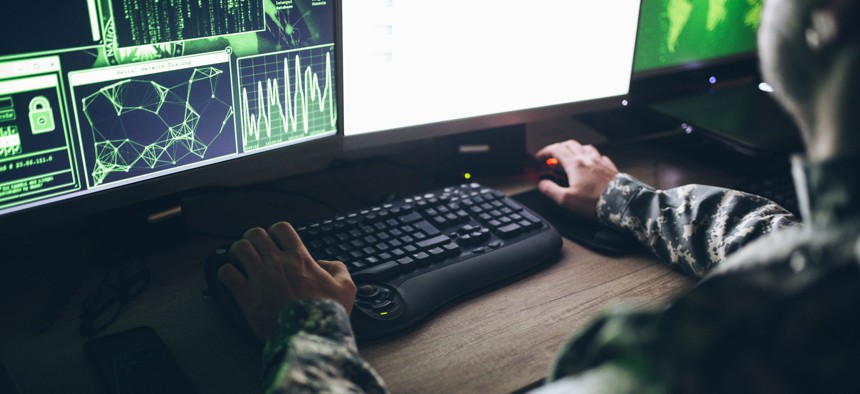
Stock image from Getty Milan_Jovic
‘Everything you see is live’ as CENTCOM shifts to digital tools
A U.S. Central Command exercise shows that operations can—and soon must—be centered on live data feeds.
The central challenge in the most recent Digital Falcon Oasis exercise was this: could digital tools enable U.S. Central Command to find, prioritize, approve, and neutralize a thousand or more threats in 24 hours?
Those who attended the post-exercise briefing may have guessed the answer when they were not emailed a massive PowerPoint deck in advance, nor greeted with a thick binder when they arrived. Indeed, the briefing embodied Central Command’s ongoing transition to digital capabilities. The event opened with a quick introduction, then immediately shifted to a digital map displaying live layers of blue and red forces in theater, annotations from team members collaborating in a shared space, and tabs for the various software tools that had been built and tested throughout the exercise.
One by one, teams across the Command and partner organizations demonstrated how the tools work—and how they plan to put them to daily use. Within three clicks, any analyst could find a remotely piloted vehicle flying over the Arabian Gulf and open up its live video feed. Within another three clicks, any logistician could view a real-time snapshot of fuel, rations, medical supplies, and more, at any base in theater. A few more clicks would join the workbench where targeteers were collaborating live on target approvals and prioritization, or another workbench where planners were building dynamic plans based on a live picture of supplies and forces in theater.
One briefing team briefly switched to PowerPoint—but only to show how their process had been run previously, and the audience cringed along with them as they described the manual, labor-intensive, error-prone system of the past.
“Everything you see is live.” Across the countless demonstrations, briefers could confirm that the data presented was either live-streamed, or at a minimum updated within the last 24 hours. For newer tools that had yet to set up those data connections, teams eagerly described their pathway and expected timeline to set up those connections, and noted where leaders in the room might be able to help facilitate.
Live data has been, and will continue to be, at the heart of CENTCOM’s efforts. It serves as the anchor to operational reality, the bridge between conceptual and functional use: without it, these software tools would have minimal impact on real-world operations. A simulated air picture can’t help an air commander identify and counter real enemy fighters that have entered the airspace. A supply report with placeholder numbers can’t inform a ground commander’s decision on how to resupply bases in theater, and the list goes on.
With each new exercise, CENTCOM can pressure-test the flow of data between real teams and live assets: from partnered live-fly events in Jordan, to HIMARS live-fire events in Kuwait, to maritime assets out in the Arabian Gulf sending reports back to shore. Teams across the Command have spent months fighting technical and policy barriers to access the critical data they need do their jobs, and they continue to fight those battles for every new data integration. That effort has resulted in over 150 live data feeds that are now at the fingertips of anyone at the Command, as well as dozens of additional data sources updated regularly.
CENTCOM’s efforts do not exist in a vacuum. Each exercise has supported a broader digital exercise series run by the Chief Digital and AI Office, where Combatant Commands and Service entities from across the Department have the opportunity to coordinate with one another, practice the use of digital tools and transfer of live data, and work towards shared operational goals.
As the post-exercise briefings drew to a close, the conversation turned to next steps. Audience members asked about the next exercise and what capabilities might be displayed 90 days from now, but briefers had a different timeline in mind: “I’m using these tools to do my job every day now. I can’t wait for the next exercise, we’re starting the next round of updates on Monday.”
The series has proven that any shift to digital warfighting must be driven by live data. Without live data, operators will be slow to adopt the tools, and quick to abandon them in a crisis where timely data is critical. The technical and operational communities must henceforth treat live feeds and inputs as the backbone of digital warfighting, and build tools to meet that standard. CENTCOM has already started down this path, and is seeing the day-to-day impact of digital warfighting based on live data.
Schuyler Moore serves as Chief Technology Officer and Brig. Gen. John Cogbill as Deputy Director of Operations of U.S. Central Command.
NEXT STORY: Defense One Radio, Ep. 136: AUSA highlights



